
#81688
Mon Aug 01 2005 07:27 PM
|
Joined: Oct 2004
Posts: 671
Petro Enthusiast
|
OP

Petro Enthusiast
Joined: Oct 2004
Posts: 671 |
 O.K. Guys, here we go... As America expanded into the western states in the 1800's, so did the need for petroleum products. Kerosene for lamps, harness oil and axle lubricants for harnesses and wagons, white gasoline for stoves, as well as other products were needed. These products were readily available in eastern markets, but hard to obtain in the west. So as prospecters had previously sought gold and silver, other men sought out oil with that same pioneering spirit. Among those men were Demetrius Scofield and Frederick Taylor, who had joined forces, to form the California Star Oil Works, on July 8, 1876. By investing in the small, Los Angeles Oil Company, Taylor & Scofield were in the oil buisness. Taylor, who went to San Francisco in 1852 at the age of 16 to distill kereosene, was lured by the promise of riches, in the newly forming oil industry. Scofield, the junior officer, a financial wizard from San Francisco, had previously worked in the Pennsylvania oil fields, and would later be instrumental in the growth of the Chevron Company. They soon found oil near Los Angeles.  It wasn't long before Pico Canyon was flowing large amounts of oil. In 1877, Pico #4, drilled only a year earlier to provide a modest amount of oil, became a gusher after being deepend, to 560 feet. Yet even with the capability to produce large amounts of oil, the company struggled. Lacking the facilities for storage, transportation, and distribution, Scofield & Taylor were looking for help. That help turned out to be George Loomis, Charles N Felton, and Lloyd Tevis, who on September 10, 1879, acquired California Star Oil Works, and formed the Pacific Coast Oil Company (PCO) 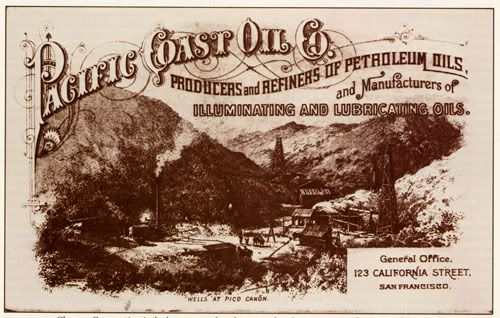 And thats enough for tonight. I'll be back tommorrow with more... [This message has been edited by Thunder (edited 08-07-2005).]
|
|
|
Please - NO offers to Buy or Sell in this forum category
Statements such as, "I'm thinking about selling this." are considered an offer to sell.
|
|

#81689
Tue Aug 02 2005 11:48 AM
|
Joined: Jan 2003
Posts: 4,160
Veteran Member
|

Veteran Member
Joined: Jan 2003
Posts: 4,160 |
Cool..I always wanted to know more about Chevron..Thanks for hosting Thunder...Cool..cant wait for more.
------------------
Hubba: GAS GEEK , OIL FREAK and humble moderator
Hubba: GAS GEEK , OIL FREAK of Seattle WA
|
|
|

#81690
Tue Aug 02 2005 07:03 PM
|
Joined: Oct 2004
Posts: 671
Petro Enthusiast
|
OP

Petro Enthusiast
Joined: Oct 2004
Posts: 671 |
All right Hubba, here's more... In order to produce high quality petroleum products, a local refinery was needed. Felton recruited workers from the oil rich state of Pennsylvania, and encouraged them to "go west". A refinery, capable of producing 600 barrels a day, was built at Alameda Point, across the bay from San Francisco. A pipe line was soon constructed between Pico Canyon, and the Southern Pacific train station, at Elayon. Now, modern day Newhall, California.  In 1895, PCO, put California's first all steel tanker, the George Loomis, into service. Capable of shipping 6500 barrels of crude oil , from Ventura to San Francisco. This marked the begining of marine operations, which later became very important to the growth of the Chevron Company. Earlier, in 1878, Standard Oil Company opened a regional sales office in San Francisco. By transporting eastern products by rail, they soon had a hold on western markets, under their subsidiary, Standard Oil Co. (Iowa). By 1900, they controlled 96.5% of the western markets in light oils. [This message has been edited by Thunder (edited 08-02-2005).]
|
|
|

#81691
Wed Aug 03 2005 07:24 PM
|
Joined: Oct 2004
Posts: 671
Petro Enthusiast
|
OP

Petro Enthusiast
Joined: Oct 2004
Posts: 671 |
But wait, there's more!!! Despite successful production, PCO had struggled through the years. As a result, PCO agreed to be acquired by Sandard Oil Co. (Iowa) in 1900, while still retaining their name. Many changes soon followed. 1901 brought a new refinery on the San Fransico Bay. Standard's tanker fleet started to grow. A new pipline was laid from Kern River and Coalinga, to the new refinery in Richmond. In 1906, Iowa Standard and PCO consolidated to create Standard Oil Company (California). The "new" company increased marketing and production in both gasoline sales, which doubled between 1906 and 1910, and lubricants, marketed under the Calumet, Petrolite, Ruddy Harvester, Zone, and Zeroline labels. 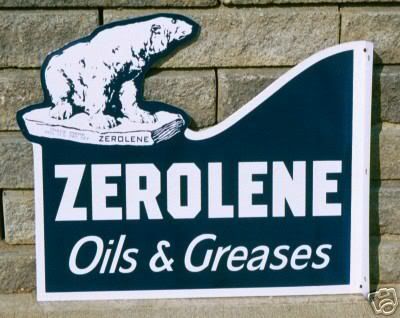 Zerolene, named for its ability to flow at zero degrees, was probably the best known of these early lubricants. Being revolutionary in their marketing, Seattle sales manager, John McLean, opened, what is believed to be, the world's first "Service Station" on a June morning in 1907 at the corner of Holgate and East Marginal Way. A 30 gallon water tank was attatched to a platform, and gravity fed from a storage tank from across the street. The gasoline, was dispensed through a garden hose, and a simple glass guage measured he amount put into the tank. Although most of the fuel was dispensed into a can, which was later poured through a funnel, with a chamois skin filter. A canvas canopy, a planked driveway, and a few shelves, to display the Zerolene oils and greases, and the first "Service Station" was built, offering none other that Red Crown Gasoline.  By 1914, 34 filling stations were in operation in Arizona, California, Nevada, Oregon, and Washington. By 1924, the number had reached almost 700 stations. All of this agressive marketing became very important, as a decision, set down in May, 1911 seperated the Standard Oil conglomerates. Such is the beginning of the Standard Oil Company (Socal). The company that we now know as CHEVRON. [This message has been edited by Thunder (edited 08-03-2005).] [This message has been edited by Thunder (edited 08-06-2005).]
|
|
|

#81692
Wed Aug 03 2005 08:05 PM
|
Joined: Oct 2004
Posts: 671
Petro Enthusiast
|
OP

Petro Enthusiast
Joined: Oct 2004
Posts: 671 |
 Chevron marketed their own line of TBA (Tires, Batteries & Accessories) products under the Atlas name. Here are a few, well all, of my Atlas items. 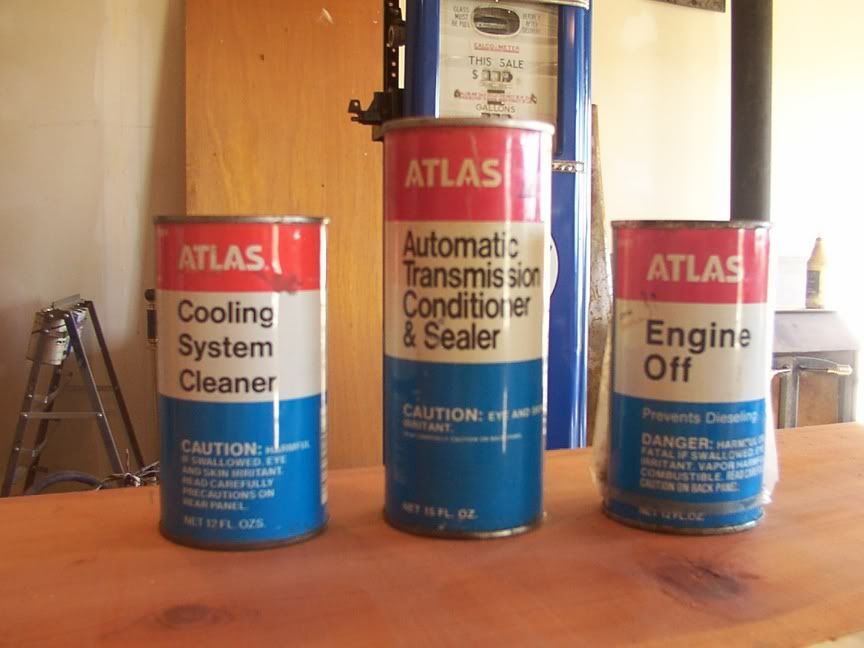 This is audience participation time. If anybody has any Atlas items that they would like to share, please jump in. If you need any help, e mail me a pic, and I'll post it for you. [This message has been edited by Thunder (edited 08-07-2005).]
|
|
|

#81693
Thu Aug 04 2005 07:57 AM
|
Joined: Oct 2004
Posts: 1,656
Veteran Member
|

Veteran Member
Joined: Oct 2004
Posts: 1,656 |
Here's my Atlas contribution. I'm enjoying the history lesson Thunder! 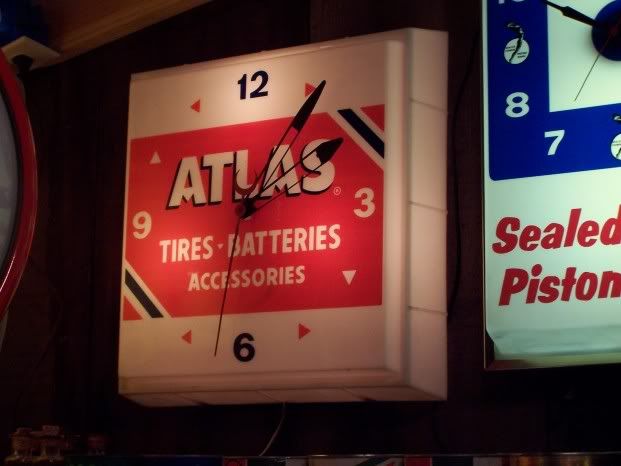 Standard had a very visible presence here on the Central Coast of California. Every small town and niche on the Coast Highway had a Standard, or later Chevron, station at one time or another. In most cases they were the first brand to pop up with an exclusive on a station. The other early stations were pumping multiple brands. Tell me when you're ready Thunder and I will post some station pictures.
C Cragg
|
|
|

#81694
Thu Aug 04 2005 04:36 PM
|
Joined: Oct 2004
Posts: 671
Petro Enthusiast
|
OP

Petro Enthusiast
Joined: Oct 2004
Posts: 671 |
Well thank you Poor Man. I appreciate the compliment. Especially from a man of your caliber. So lets go with your suggestion, and talk a little about some of the early service stations. "In 1931, Standard Oil Company of California, after many pioneering years in the service station business, transferred the responsibility to concentrate on and further perfect the retail marketing of its automobile petroleum products to a new corporation... Standard Stations, Inc." So started the January, 1941 issue of STANDARD CHEVRON, a monthly publication for Socal employees. An issue that celebrated their ten years of customer service. Now, would also be a good time to thank the good people at Chevron, who have been invited to this forum, for their assistance in providing me the information to produce this. I thank both John Harper, historian and Linda Burton, from the archive office, for their gracious support. Thank You. 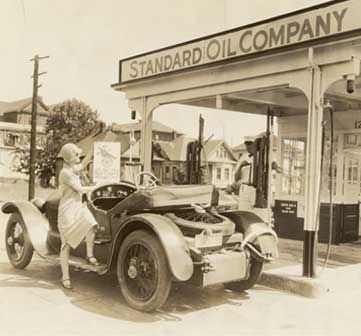 Lets take a look at a few early Chevron Stations. We see a shed type building, with the canopy extending out only to the pump block. A sign, reading "Standard Oil Company" adorns the building. Drive slowly, please, as the gravel drive is easily disturbed, and the smooth affect is produced with tedious raking and pulling. Our attendant is scrubbing the white fabric hose of one of the two pumps at the station. Our attendant also spends his 60 hour work week by "bricking" the station floor, and dusting & cleaning the stock & equipment. Lucky for him, that at this time, he only has limited facilities for battery & lubrication service, and only a small stock of non-petroleum products.  As this continues, I will post some of the yearly milestones reached by the Standard Stations. By the way Curt, we had a clock just like that at the Chevron Station that I worked at while I was in High School. What else do you have for us? [This message has been edited by Thunder (edited 08-04-2005).] [This message has been edited by Thunder (edited 08-04-2005).]
|
|
|

#81695
Thu Aug 04 2005 04:46 PM
|
Joined: Nov 2004
Posts: 9,346
Veteran Member
|

Veteran Member
Joined: Nov 2004
Posts: 9,346 |
Here is a large porcelian Standard Oil Co of California sign with the red white & blue colors on the end. Sign is over 20 ft long. 
Wanted Owens Motor Oil & Mobiloil Gargoyle. Brad Ralston & my website is www.petrobarn.com
|
|
|

#81696
Fri Aug 05 2005 05:44 AM
|
Joined: Oct 2004
Posts: 671
Petro Enthusiast
|
OP

Petro Enthusiast
Joined: Oct 2004
Posts: 671 |
Thanks Gasoildude. Check out that Chevron logo. That is the older design, there were a few changes through the years. Although Socal used the "Chevron" as a symbol, it did not become a part of their name untill later. I'll have more about that in a few days...
|
|
|

#81697
Fri Aug 05 2005 06:49 PM
|
Joined: Oct 2004
Posts: 671
Petro Enthusiast
|
OP

Petro Enthusiast
Joined: Oct 2004
Posts: 671 |
More from the 10th Anniversary issue of "STANDARD CHEVRON"
"Let us turn back the pages of history to the year 1930...
Standard Stations, Inc. is yet to appear on the scene, though its formation is underway. Standard Oil Company of California has been successfully operating service stations since 1907 when they built, in the city of Seattle, what is generally recognized as the first service station in America. Since that time the Parent Company erected an ever- increasing number of stations to market Red Crown Gasoline, Zeroline Motor Oil and other petroleum products in five western states. In December, 1928, the Parent Company leased out the Company-Operated stations, in the majority of cases to employees, and subsequently, during 1929, the following marketing companies were formed to operate 684 of these stations located in Washington, Oregon, and California, the nucleus of Standard Stations, Inc.:
1. San Francisco Gasoline Stations
2. Bay Counties Gasoline Stations
3. Coast Counties Gasoline Stations
4. Southern Gasoline Stations
5. San Joequin Gasoline Stations
6. Valley Gasoline Stations
7. Oregon Gasoline Stations
8. Northwestern Gasoline Stations
Each of these Marketing Companies Administers their seperate merchandising policies according to their own standards. Therefore, motorists find little in common at the various Standard Oil Stations throuhgout the west, and seldom feel at home except at their neighborhood stations."
It can easily be seen that Standard Oil Co. (California) sensed the need for more uniformity in their service stations in the late 1920s. As such, it was recognized that the various marketing companies needed to be consolidated as one entity. Hence, the forming of Standard Stations Inc.
Next stop, some of the major milestones achieved in the first 10 years of operations...
[This message has been edited by Thunder (edited 08-06-2005).]
|
|
|

#81698
Fri Aug 05 2005 07:54 PM
|
Joined: Oct 2004
Posts: 671
Petro Enthusiast
|
OP

Petro Enthusiast
Joined: Oct 2004
Posts: 671 |
1931
Program of extensive yard paving started... eliminated raking and soaking... enhanced appearance of station
Atlas Tires & Tubes made available at 300 stations
Tire display racks installed
Permanent metal bulletin boards replaced old wooden A boards
Atlas Batteries added to stations resale stock
Tire warehouses established at key points
Initial battery charging equipment installed
Chevron sign adopted at Standard Stations, Inc., As official indentification sign
Standard Lubrication System Chek-Chart supplied
Uniform resale stock of accessories placed at all stations including: Spark plugs, Westinghouse lamps and Atlas Fan Belts
Regular work week 60 hours
Tire & Battery Manuals introduced
1932
Spokane Division Office building constructed
3-compartment, 10 gallon lubricating oil tanks, oil bottles, and bottle stands installed
Neon Chevron signs installed at all stations. Program of Neon outlining of all stations completed
Station Managers supplied with especially designed Chevron badge.
Standard Chevron Magazine first published.
Working hours reduced from 60 to 50 hours per week.
Flight and Standard Penn Motor Oils introduced.
Flight Gasoline introduced.
1933
San Diego office constucted.
Water facilities at pump block improved.
First cash boxes installed adjacent to pumps.
Large plate glass replaced small multiple pane windows.
Standardized uniforms adopted.
Uniform window displays installed.
60-day Budget Terms made available to tire purchasers.
Working hours reduced from 50 to 48 hours per week.
Salvage Depot installed at key warehouses to maintain and service station equipment.
1934
Pasadena Division Office building constructed.
Travel With Us booklets distributed at strategically located gateway stations.
Atlas Tires publicized in a series of American Weekly Advertisements.
300 large billboard posters installed at strategically located stations.
Under-the-hood battery records distributed.
Merchandising Manual distributed to field.
Commenced program of replacing visible pumps with computor type pumps.
Standard Unsurpassed with Tetra-ethyl introduced.
Comprehensive reconstruction program undertaken to enhance the uniformity and the apparance of stations.
1935
Standard Stations Inc. expanded into Texas & Utah.
90-day Budget Terms... extended payment period on tire, batteries and accesories.
Junior Atlas Tire and Battery line introduced.
General Salary increase.
Sales unit requirement for A and B stations reduced.
1936
Rpm Motor Oil introduced.
Travel Information Folders introduced.
Metal guest chairs provided for lubrication customers.
Trade-in allowance granted on old tires.
Chevron Cleaning Solvent added to resale stock at many stations.
Atlas "Grip Safe" "Lug Grip" and White sidewall tires introduced.
One week vacation with pay granted.
Salt Lake City Division was established.
1937
Air cleaner service introduced.
Christmas Cards made available to station Managers to send to customers.
Uniform windsheild service adopted.
Colorful poster stamps distributed in conjuntion with Travel With Us Booklet.
Removable Standard Lubrication Procedure page made available.
Initial light truck lubrication service offered.
All basic salaries rates revised upward.
$5 laundry allowance granted to all employees.
"E" station classification eliminted... raised these stations to "D" classification.
1938
Hood-dex metal Under-the-Hood record holders introduced.
Industrial Injury Benefits Plan adopted.
Black synthetic rubber gasoline hoses installed on all new and reconditioned pumps.
Vacations extended to two weeks with pay for employees with three or more years service.
Group Life Insurance plan adopted.
Saturday Evening Post advertising launched.
Service pins presented to all employees with five or more years of service.
Standard Chevron increased in size.
Albuquerque Division was established.
National Credit Cards introduced.
1939
Gateway billboards constructed at strategic locations on boundries of our marketing area.
Initial installation of air and water wells at pump block.
Windsheild servicer installed at pump block.
Atlas Perma-Guard and Sealed beam lamps introduced.
Whisk broom service adopted at all stations.
Travel Tykes Weeklies distributed at all Standard Stations.
Standards Stations Fleet Service Plan introduced.
General salary increase granted to employees with one year or more of service.
A large number of Packard cars factory equipped with Atlas Tires.
Free physical examinations offered every two years for all employees up to 40 years of age and annually thereafter.
All station managers given option of Sundays off between October 1 and April 1.
Travel routings made availble through the Standard Travel Information Service.
1940
New streamlined Company Operated Chevron signs erected.
New Authorized Distributor Chevron sign, with or without neon, made available to distributors.
Standards Supreme Gasoline (with Ethyl) introduced.
Provided uniform type of brand designation on face of pumps...canteen globes removed.
Adjustment period allowance granted to employees, with one year or more service, inducted into military or naval training for one year.
Combination Black and White sidewall Atlas tires introduced.
New Atlas Auto Polish introduced.
Lubrication pamphlet distributed.
[This message has been edited by Thunder (edited 08-06-2005).]
|
|
|

#81699
Sat Aug 06 2005 07:44 PM
|
Joined: Oct 2004
Posts: 671
Petro Enthusiast
|
OP

Petro Enthusiast
Joined: Oct 2004
Posts: 671 |
Lots of stuff going on in the first ten years of Standard Stations Inc. Just for the pump restoration folks, lets look at some of the highlights... 1932: Flight Gasoline was produced 1934: Commenced program of replacing visible pumps with computor type pumps 1938: Black synthetic hoses were installed on new & reconditioned pumps 1940 Canteen globes were removed Standard Supreme with Ethyl was introduced. Some of these highlights should help for a more accurate restoration. But... The year 1936 gave us RPM motor oil. Probably one of the more well known Chevron products. 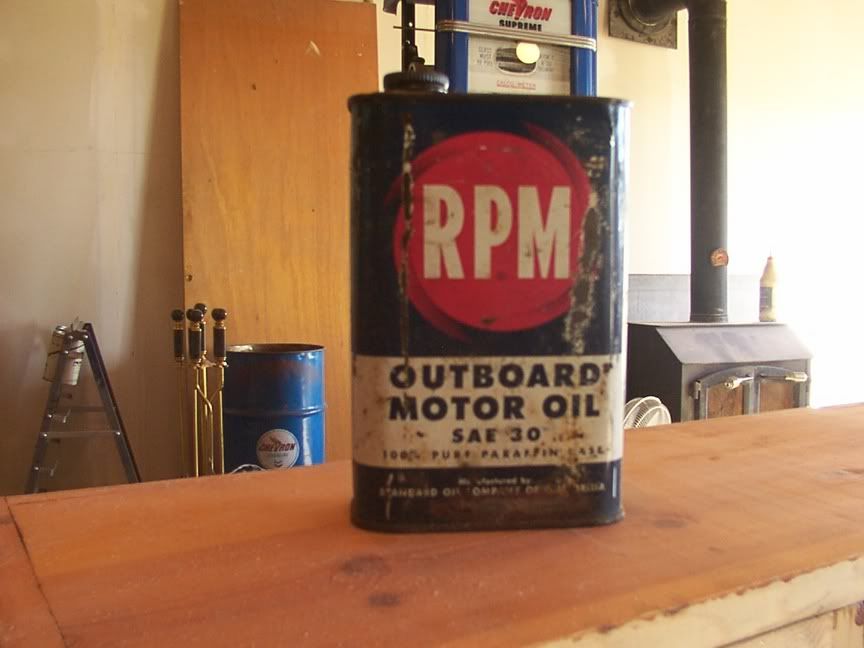 This is my entire collection of RPM Oil cans. Who else would like to share? If you need help posting a photo, e-mail it to me, and I'll post it for you. [This message has been edited by Thunder (edited 08-07-2005).]
|
|
|

#81700
Sun Aug 07 2005 04:32 PM
|
Joined: Oct 2004
Posts: 671
Petro Enthusiast
|
OP

Petro Enthusiast
Joined: Oct 2004
Posts: 671 |
Here are a few more pics of some RPM stuff that I stumbled across. 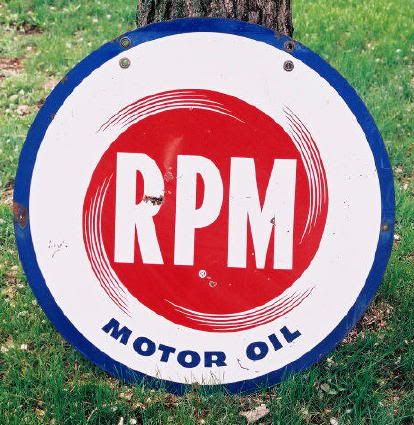 This is a rather nice porcelean sign. 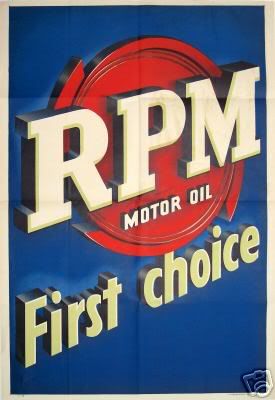 A poster, that recently came up on E-bay  And an oil can rack sign, that I missed out on... 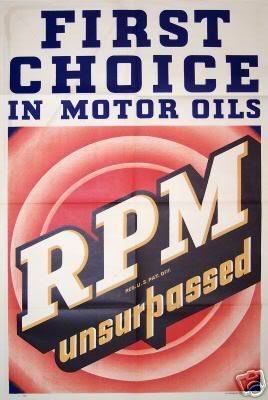 and anothe RPM poster.  And one of one of my favorite cartoon characters, none other that Donald Duck. During the 1930's, Socal did some advertising with some Disney characters... [This message has been edited by Thunder (edited 08-07-2005).]
|
|
|

#81701
Sun Aug 07 2005 04:39 PM
|
Joined: Oct 2004
Posts: 671
Petro Enthusiast
|
OP

Petro Enthusiast
Joined: Oct 2004
Posts: 671 |
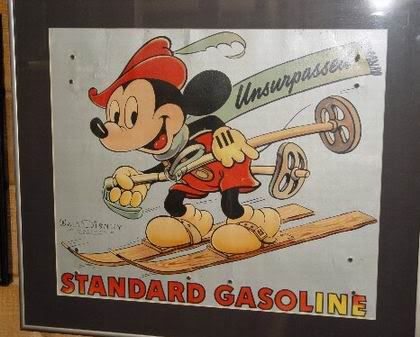 Here's one of Micky Mouse  And another...
|
|
|

#81702
Sun Aug 07 2005 09:06 PM
|
Joined: Oct 2004
Posts: 1,656
Veteran Member
|

Veteran Member
Joined: Oct 2004
Posts: 1,656 |
I promised Thunder that I would help him with his "ompany of the Month" so I guess I better get with it. Standard Oil was well represented on the Central Coast of California in the early establishment of service stations. One of the main reasons is that they quickly established a bulk plant in the town of Los Olivos. If you have visited Los Olivos anytime in the last thirty years, you would know that it is an unlikely location for a bulk plant since it is not on a major highway and the town is relatively small (around 1,000-2,000 people today). However, at one time it was the end of the line for a narrow gauge railway running from Avila Bay in San Luis Obispo County. This allowed Standard to ship oil from San Francisco down the coast and unload it onto tanker rail cars destined for Los Olivos. From there it was trucked throughout the central coast of California to the outlying towns and ranches serving the commmunity from the early 1900's until the 70's. 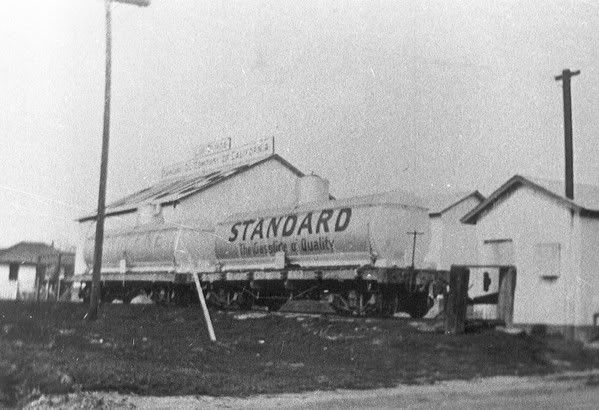 The bulk oil products were unloaded from the tank cars into tanks and then into bulk cans and loaded onto trucks like this early one. 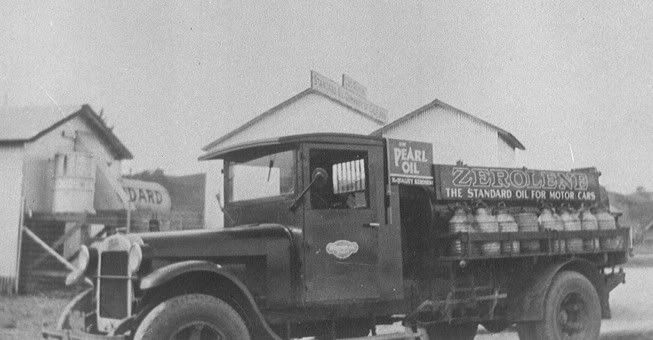 As a result of this central distribution point, Standard was able to establish stations in practically every small town and bend in the Coast Highways very early on during the development of the roads.
C Cragg
|
|
|
|
|

